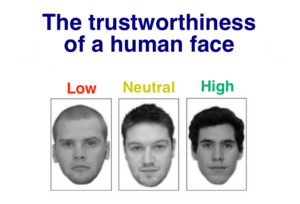“I have a dream that my four little children will one day live in a nation where they will not be judged by the color of their skin but by the content of their character.”
The aspirational words of Dr. Martin Luther King, Jr. remain just that – aspirational, particularly in the courtroom. And were Dr. King to by uttering those words today, he might add that people should not “be judged by the color of their skin or the furrowing of their brow.” Why, because a recent study confirms that facial stereotypes – how people extrapolate character and trustworthiness from different facial expressions or structures – can affect judgments in issues as fraught as whether to return a sentence of death.
Do a web search for “trustworthy and untrustworthy faces” and you’ll find an abundance of research and images. Here is one visual that typifies what is shown:

https://waitbutwhy.com/2014/08/makes-face-trustworthy.html (last visited January 6, 2024).
Where does this bias originate? A 2022 paper explained that “[f]acial appearance plays a decisive role during impression formation… Drawing trait inferences from faces occurs extremely fast (i.e., within 100 milliseconds…) and appears early in childhood…[T]rustworthiness judgments tend to guide peoples’ decisions, even when other more diagnostic cues are available…” Panderada et al, Can I Trust This Person? Evaluations of Trustworthiness From Faces and Relevant Individual Variables, https://www.ncbi.nlm.nih.gov/pmc/articles/PMC9127658/ (last visited January 6, 20-22).
But is how someone appears, regardless of what else we know about them, truly a thumb on the scale of justice? A recent research study says “yes.” After surveying the literature, the authors reported that studies have demonstrated that “prisoners in the Florida criminal justice system who were judged to have more untrustworthy-looking faces were more likely to be sentenced to death as opposed to life in prison. They also found that these biases were reflected in naive participants’ hypothetical sentencing decisions…” Hong, Chua and Freeman, Reducing Facial Stereotype Bias in Consequential Social Judgments: Intervention Success With White Male Faces, Sage Journals 2023.
The three researchers then tried to eliminate or reduce the bias by what they call “counterstereotype training.” Half of the study participants were shown faces – all of white males – that either highly correlated with trustworthy or untrustworthy facial characteristics. Yet each face had a tag line – typically trustworthy faces might be labeled “took a bribe” while typically untrustworthy faces might be tagged “volunteers at a homeless shelter.” The other half received no “counterstereotype training.” All study participants were unaware of what was actually being tested, believing this to be a memory exercise. When subsequently confronted with hypothetical guilt/non-guilt verdicts and sentencing scenarios, those who had undergone the training ended up with reduced “reliance on facial trustworthiness in consequential social judgments.” Said more simply, how the person’s face appeared stopped being the thumb on the scale.
Before hope takes over and we declare victory over biased judgments, several cautionary notes need to be raised. The study authors note that they can’t tell if the “training” has lasting effects as opposed to a short-term impact when the training is followed promptly by the decision-making exercise. And if it does work, what Judge will permit this in the courtroom or even allow voir dire on the concern. The authors also note that this study was undertaken with only white faces, so whether and how this would play out if racial diversity were also in the mix can’t be predicted.
The remaining cautionary notes involve race and gender. A compelling study from 2006 showed that even with a cohort of Black defendants facing the death penalty, the more the accused ‘looked Black,’ i.e. “broad nose, thick ,lips, darker skin,” the greater the likelihood of a death sentence when the victim was white. Eberhardt et al, Looking Deathworthy: Perceived Stereotypicality Of Black Defendants Predicts Capital-Sentencing Outcomes, Psychol Sci. 2006 May;17(5):383-6. [Where the victim was Black, the stereotypicality effect was null.] A visual illustrates what was found:

Move ahead to 2023 and the focus turns to victim photos, in particular the impact on a trial of having no photos of the homicide victim, post-mortem photos of the homicide victim, or post-mortem and-pre-death [normal life] photos of the homicide victim. Using only White mock jurors with a balanced case file, the results were racially skewed. As the authors detail,
- The gruesome photograph effect [post-mortem] is evident for White and Latina victims, but not Black victims, because White mock jurors felt increased other condemning emotions, such as anger and disgust, on behalf of a White or Latina victim who had been harmed, but not for a Black victim who had been harmed in the exact same manner.
- [S]eeing the combination of photographs of the victim happy and alive and then seeing that victim with a slit throat on an autopsy table was even more emotionally impactful than seeing the gruesome postmortem photograph alone—but this was limited to only White victims.
- And these selective moral responses mattered: The differential impact of victim photographs on mock jurors’ moral emotions was associated with an increased likelihood of blaming and convicting the defendant.
Phalen et al., White Mock Jurors’ Moral Emotional Responses to Viewing Female Victim Photographs Depend on the Victim’s Race, Law and Human Behavior 2023, Vol.. 47, No. 6, 666-685.
The over-arching lesson? Facts are inseparable from emotions, and emotions remain driven by stereotype. We judge by what we ‘see,’ not by what he have learned.
